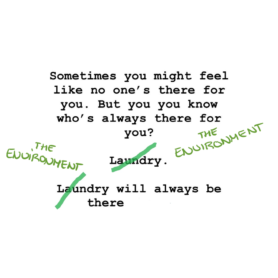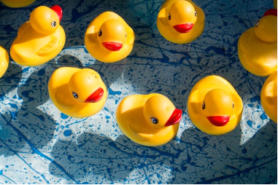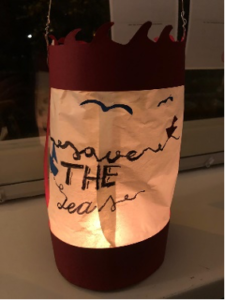All posts
Pandemic, Plastics and Politicians: room for environmental action from your own home
 By Johanna Bürkert
By Johanna Bürkert
@BuerkertJohanna

© Olivia White (@housofwhite) – 14. February 2019 – with modification by author
With the all too well-known virus and alongside side effects dominating the news, it is sometimes easy to forget that there is also other stuff going on in this world (like…that overflowing pile of laundry, anyone?). While I do not (in any way) want to downplay the importance of staying informed, I sometimes catch myself feeling overwhelmed and, well, for lack of a better word, discouraged after my morning news reading. So, let’s take a break from the pandemic news (I promise, this is the last time that I will use the p-word) and talk about the environment for a bit, shall we?
One of our aims is to find out where the plastic that arrives at the Galápagos Islands is coming from. If we know more about its origins, we can focus on what we can actually do about it. Fun fact – did you know that about 80% of plastic in the oceans comes from just 1000 rivers all over the world?[1] In one of our last posts we have already looked at the magical box full of complicated definitions, treaties and things happening far away (as far as the Galápagos to be precise). What, however, happens if we look at the box not as the box of mystery and complicatedness, but as a toolbox that we can employ to try and contribute to solving some of our problems?
As we already mentioned, the treaties that we discussed are not really effective to address plastic pollution. They are like a net with large holes, and the plastic rubbish simply falls through. However, what if we look at a different kind of law?
That’s where environmental law comes in. Now, keep in mind that this differs by country and that every country has their own system of approaching it. The Netherlands, who are a member of the European Union, for example, have joined efforts with other European countries and created a set of directives (those are rules made by the EU that all the Member States are obliged to adhere to) that regulate water quality. One of those is the Marine Strategy Framework Directive, the other one is the EU Water Framework Directive. Both of these directives set standards for water quality. The Marine Strategy Framework Directive looks at the sea and coast, and the EU Water Framework Directive looks more at the water quality in rivers and streams and some (smaller) parts of the coast. So they partly overlap.
 How do we get our water quality standards, and how do we make sure that they stay the same? Let’s take rubber ducks as an example. A directive could say that you are not allowed to have more than one rubber ducky per bucket of water, otherwise your water quality is too bad. Member States will then have to check ever so often if the amount of rubber ducks hasn’t increased. If it does increase, they have to look for the cause of this increase in duckies. This is because they need to solve the problem, and not just take the duckies out. Maybe somebody sneakily thought it would be a good idea to have a rubber ducky race? By the way – If you want to find out more about rubber ducks and how they disperse in the ocean, you can check out this really cool simulation tool HERE.
How do we get our water quality standards, and how do we make sure that they stay the same? Let’s take rubber ducks as an example. A directive could say that you are not allowed to have more than one rubber ducky per bucket of water, otherwise your water quality is too bad. Member States will then have to check ever so often if the amount of rubber ducks hasn’t increased. If it does increase, they have to look for the cause of this increase in duckies. This is because they need to solve the problem, and not just take the duckies out. Maybe somebody sneakily thought it would be a good idea to have a rubber ducky race? By the way – If you want to find out more about rubber ducks and how they disperse in the ocean, you can check out this really cool simulation tool HERE.
If a state fails to achieve this water quality and keeps having too many rubber ducks, it will have to take measures to make sure that the amount of rubber ducks in the water goes down again. In the EU, plastics are regulated under the Marine Strategy Framework Directive, which says you can’t have more than x number of rubber ducks (and other plastic pieces) in the water. But if we look at the rivers, where most of the plastic comes from, it becomes more difficult. If the rubber ducks contain so-called hazardous substances (that means they are thought to be poisonous for the environment or humans), there are standards on how of many can be in the river water. But for other types of rubber ducks there are not that many standards. This means that the Water Framework Directive’s standards actually don’t really match the Marine Strategy Frameworks Directive when it comes to standards for plastic. Interesting right? Also, did you know that Member States can decide to make extra standards about their rivers, if they think that plastic harms the environment? That means we’re having plastic in the ocean that came there through rivers, but the quality standards don’t really work well together. I think you can all agree that it would be better to align these directives to make sure the plastic doesn’t even reach the ocean…
For that, we need laws that work together in a better way. A nice first step would be to better match the Water Framework Directive and the Marine Strategy Framework Directive. But what if we not only look at cleaning the rivers, but also at the effects of products on the environment? The best would be to have rules that take care of products already at the beginning of their life – if we look at how dangerous a product is for the environment before we start using it, then we can try and find alternatives before we have to deal with the consequences.
 Back to the toolbox. Fun fact: did you know that it is really common in the U.S.A to write to your representatives (the people you elected) if things are going wrong and you’d like them to change it? Why don’t we all do that sometimes… It is good to have tools available, but we also need to be able to use them properly and work with multiple tools, otherwise problem-solving will be hard. So, if you find yourself like there is nothing you can do – send your local politician a card and who knows…it might just be the extra sign they need. Or make a nice lantern and place it in your window (I’m sure it will be prettier than my attempt ?) And speaking of cards – please also send one to your mom/grandma/uncle/best friend/neighbour. Trust me, they need it too.
Back to the toolbox. Fun fact: did you know that it is really common in the U.S.A to write to your representatives (the people you elected) if things are going wrong and you’d like them to change it? Why don’t we all do that sometimes… It is good to have tools available, but we also need to be able to use them properly and work with multiple tools, otherwise problem-solving will be hard. So, if you find yourself like there is nothing you can do – send your local politician a card and who knows…it might just be the extra sign they need. Or make a nice lantern and place it in your window (I’m sure it will be prettier than my attempt ?) And speaking of cards – please also send one to your mom/grandma/uncle/best friend/neighbour. Trust me, they need it too.

